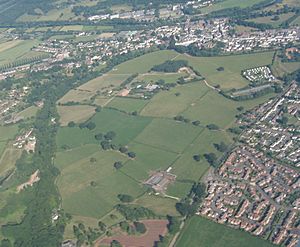Vauxhall Fields, Monmouth facts for kids
Quick facts for kids Vauxhall Fields |
|
|---|---|
| Vauxhall Meadows | |

Aerial photo of Vauxhall Fields from the northwest, looking southeast
|
|
| Location | Monmouth, Wales |
Vauxhall Fields, also called Vauxhall Meadows, are special grassy areas near the River Monnow in Monmouth, Wales. These fields are often wet because they are "water meadows," which means they are sometimes covered by river water. They are special because they have mostly stayed natural, without many buildings. Sometimes, the river floods these fields, making them even wetter!
Contents
History of Vauxhall Fields
Long ago, before 1880, Vauxhall Fields was mostly farmland. It was actually several smaller fields, like Castle Field Meadows. People think that Castle Field was where an important battle happened in 1233. This battle was between King Henry III's supporters and Richard, the Earl of Pembroke.
Later, in the late 1700s, a part of the fields became a fun place called "pleasure grounds." Mr. Tibbs, who owned the Beaufort Arms Hotel, created them. He named them Vauxhall, just like the famous Vauxhall Gardens in London.
Vauxhall Farmhouse
There's an old building called Vauxhall Farmhouse nearby. It's a Grade II Listed building, which means it's an important historical building. It has been protected since 2005. The farmhouse is about 500 meters north of Monmouth Castle. It looks out over Vauxhall Meadows.
Events and Activities
For many years, from 1946 to 2006, the Monmouthshire Show used Vauxhall Fields. This big show, which features farming and local events, was not held in 1956 or 2001 because of foot-and-mouth disease outbreaks.
The fields were also used by Haberdashers' Monmouth School for Girls for their sports. They played there until the 1980s, when the school got its own playing fields.
More recently, Vauxhall Fields has been a place for many fun events. These include the Wales International Kite Festival, steam engine shows, Scout jamborees, dog shows, and horse jumping. People also enjoy guided walks, fun runs, and hot air balloon flights there.
Horse Racing at Vauxhall Fields
Horse racing has a long history in Monmouth, starting as early as 1734. The first races were held at Chippenham Park. It's not clear exactly when the races moved, but by 1902, Monmouth Races at Vauxhall Fields were very important for national horse racing.
The fields were used for races until 1933. This marked the end of almost 200 years of horse racing in Monmouth. Old maps from 1900 to 1930 clearly show the racecourse layout and where the Grandstand used to be. There is only one known photo of the races in action, taken around 1925.
Vauxhall Camp
The Royal Monmouthshire Royal Engineers (Militia), also known as R MON RE(M), have a camp on Vauxhall Fields. These army engineers built a bridge called White Bridge in 1905. It was built by No.2 Company of the Monmouthshire Regiment and crossed the River Monnow.
In 1931, the White Bridge was replaced by an Inglis Bridge, which is still there today. The army announced in 2011 that vehicles would no longer be allowed on this bridge. The Royal Monmouthshire Royal Engineers have also used the field for special ceremonies, like giving out medals.
Air Field
On August 25, 1912, a small biplane aircraft made history. It was the first airplane ever to land in Monmouth, touching down on Vauxhall Fields. The plane flew all the way from Salisbury Plain, stopping in Weymouth. Lieutenant Fox was the pilot. The ground was very wet, so the plane had to leave with only the pilot on board because it couldn't carry more weight. We don't know why this event happened.
Golf at Vauxhall Fields
A golf club called Vauxhall Golf Club started in 1892. Most of its members were army personnel stationed in the town. Later, Monmouth Golf Club took over Vauxhall Golf Club. They used Vauxhall Fields for golf until 1903. The club then moved to the Hendre Estate because Vauxhall Fields were not quite right for golf.
Images for kids













